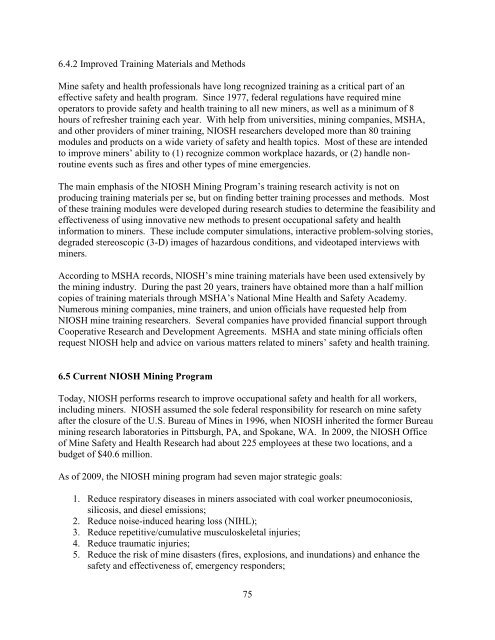One Hundred Years of Federal Mining Safety and Health Research
One Hundred Years of Federal Mining Safety and Health Research
One Hundred Years of Federal Mining Safety and Health Research
- No tags were found...
You also want an ePaper? Increase the reach of your titles
YUMPU automatically turns print PDFs into web optimized ePapers that Google loves.
6.4.2 Improved Training Materials <strong>and</strong> Methods<br />
Mine safety <strong>and</strong> health pr<strong>of</strong>essionals have long recognized training as a critical part <strong>of</strong> an<br />
effective safety <strong>and</strong> health program. Since 1977, federal regulations have required mine<br />
operators to provide safety <strong>and</strong> health training to all new miners, as well as a minimum <strong>of</strong> 8<br />
hours <strong>of</strong> refresher training each year. With help from universities, mining companies, MSHA,<br />
<strong>and</strong> other providers <strong>of</strong> miner training, NIOSH researchers developed more than 80 training<br />
modules <strong>and</strong> products on a wide variety <strong>of</strong> safety <strong>and</strong> health topics. Most <strong>of</strong> these are intended<br />
to improve miners’ ability to (1) recognize common workplace hazards, or (2) h<strong>and</strong>le nonroutine<br />
events such as fires <strong>and</strong> other types <strong>of</strong> mine emergencies.<br />
The main emphasis <strong>of</strong> the NIOSH <strong>Mining</strong> Program’s training research activity is not on<br />
producing training materials per se, but on finding better training processes <strong>and</strong> methods. Most<br />
<strong>of</strong> these training modules were developed during research studies to determine the feasibility <strong>and</strong><br />
effectiveness <strong>of</strong> using innovative new methods to present occupational safety <strong>and</strong> health<br />
information to miners. These include computer simulations, interactive problem-solving stories,<br />
degraded stereoscopic (3-D) images <strong>of</strong> hazardous conditions, <strong>and</strong> videotaped interviews with<br />
miners.<br />
According to MSHA records, NIOSH’s mine training materials have been used extensively by<br />
the mining industry. During the past 20 years, trainers have obtained more than a half million<br />
copies <strong>of</strong> training materials through MSHA’s National Mine <strong>Health</strong> <strong>and</strong> <strong>Safety</strong> Academy.<br />
Numerous mining companies, mine trainers, <strong>and</strong> union <strong>of</strong>ficials have requested help from<br />
NIOSH mine training researchers. Several companies have provided financial support through<br />
Cooperative <strong>Research</strong> <strong>and</strong> Development Agreements. MSHA <strong>and</strong> state mining <strong>of</strong>ficials <strong>of</strong>ten<br />
request NIOSH help <strong>and</strong> advice on various matters related to miners’ safety <strong>and</strong> health training.<br />
6.5 Current NIOSH <strong>Mining</strong> Program<br />
Today, NIOSH performs research to improve occupational safety <strong>and</strong> health for all workers,<br />
including miners. NIOSH assumed the sole federal responsibility for research on mine safety<br />
after the closure <strong>of</strong> the U.S. Bureau <strong>of</strong> Mines in 1996, when NIOSH inherited the former Bureau<br />
mining research laboratories in Pittsburgh, PA, <strong>and</strong> Spokane, WA. In 2009, the NIOSH Office<br />
<strong>of</strong> Mine <strong>Safety</strong> <strong>and</strong> <strong>Health</strong> <strong>Research</strong> had about 225 employees at these two locations, <strong>and</strong> a<br />
budget <strong>of</strong> $40.6 million.<br />
As <strong>of</strong> 2009, the NIOSH mining program had seven major strategic goals:<br />
1. Reduce respiratory diseases in miners associated with coal worker pneumoconiosis,<br />
silicosis, <strong>and</strong> diesel emissions;<br />
2. Reduce noise-induced hearing loss (NIHL);<br />
3. Reduce repetitive/cumulative musculoskeletal injuries;<br />
4. Reduce traumatic injuries;<br />
5. Reduce the risk <strong>of</strong> mine disasters (fires, explosions, <strong>and</strong> inundations) <strong>and</strong> enhance the<br />
safety <strong>and</strong> effectiveness <strong>of</strong>, emergency responders;<br />
75
















